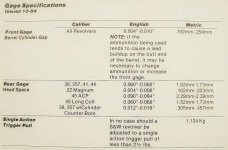Oscar Zulu
Member
What kind of feeler gauges do I need to check the barrel cylinder gap on revolvers, and where do I get them?
I have a rebarreled Python that seems to have a rather generous B/C gap. My automotive feelers are to thick to be effective. Where do I find the right gauges?
Thanks,
OZ
I have a rebarreled Python that seems to have a rather generous B/C gap. My automotive feelers are to thick to be effective. Where do I find the right gauges?
Thanks,
OZ

